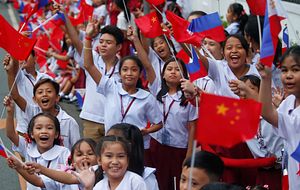The suspension of work in the Philippines’ capital and the wreath laying ceremony honoring Filipino national hero Jose Rizal captured the warm welcome of President Rodrigo Duterte to his new-found big brother, Chinese President Xi Jinping. Xi is paying a two-day state visit to the Southeast Asian nation, his first since assuming office in 2013.
There were doubts about the Chinese leader’s stopover in sunny Manila after his weekend attendance at the Asia Pacific Economic Cooperation (APEC) summit in Papua New Guinea. The annual APEC meeting concluded without an agreed joint communiqué for the first time in its 25-year existence, which reports blamed on tensions between the United States and China. Just before APEC, the media also caught mercurial Filipino leader Duterte skipping the regional summit dinner and missing multiple meetings in favor of naps at the Association of Southeast Asian Nations Summit in Singapore.
But despite the less-than-auspicious events of the previous week, in Manila Duterte and Xi took advantage of their expanded bilateral meeting to reaffirm the deepening of China-Philippines relations. Xi’s state visit was profoundly dubbed as the “rainbow after the rain,” deliberately aimed at cementing the once-broken lines of good neighborliness and friendship. The bonhomie carried on despite the untimely release of poll results pointing to anti-Chinese sentiments in the Philippines just before the red carpet was rolled out for Xi (in a double blow, the poll also revealed far higher levels of trust in the United States). Still, the arrival of Xi in Manila marked a new beginning. Beijing had a sour relationship with the archipelagic country under Duterte’s predecessor, Benigno Aquino III, who initiated the international arbitration case against China’s claims in the contested South China Sea. That process culminated in a damning 2016 ruling that found in the Philippines’ favor on nearly every count.
Now confident in displaying its eminent role in the region through the nebulous Belt and Road Initiative (BRI), China is offering multibillion dollar investment pledges to its smaller neighbors. But Filipino critics worry about China’s offer of economic opportunity to the Philippines in exchange for appeasement. Worries only increased after cautious remarks from other Southeast Asian leaders about the potential debt trap a nation may encounter after signing dozens of juicy Chinese agreements.
This mixture of both danger and opportunity is even more apparent when taking into account the overlapping claims between China and the Philippines in the South China Sea (known in Manila as the West Philippine Seat). This dispute has helped galvanize tough anti-Chinese sentiments among Filipinos, leading to both a mixed reaction to Xi’s official visit in Manila and, more broadly, criticisms of Duterte’s inaction to China’s intrusion in and militarization of the disputed areas. The pragmatic Filipino leader is inclined to soft-pedal the territorial disputes, most recently shown through his baffling rhetoric that China “is already in possession” of the contested waterway. To some eloquence, that defeatist statement is tantamount to complete surrender of Manila’s claims.
The Philippines’ strategic role as a guinea pig for Chinese crisis management hints at an improving mutual understanding between the David and Goliath neighbors to seek the best formula for peace. It’s tempting for Manila to focus solely on China’s burgeoning economic and trade relations with the Philippines, but the volatility of the two nations’ defense and security relations clearly shows how economy and security are intertwined.
In terms of the disputes, the major takeaway from Xi’s visit is expected to be a heavily debated framework for joint exploration in the South China Sea, referencing the October 2016 Joint Statement of China and the Philippines on joint exploration undersea and the November 2017 Mutual of Understanding on Energy Cooperation. The most famous previous example, the 2004 Joint Marine Seismic Undertaking, was signed by China and the Philippines, with Vietnam joining the agreement later on to explore the South China Sea for oil and natural gas. The ground-breaking agreement quickly imploded into diplomatic and legal battles. The final death knell sounded in February 2013 when the Philippines initiated its arbitration case against China.
In implementing its hedging strategy, the Philippines should be cautious to avoid economic dependence on China in return for financing the Duterte administration’s robust infrastructure program. Manila should remember it has options, as other major powers — including the United States and Japan — continuously invest far more than China.
Dr. Chester Cabalza is a security analyst.

































